Trams in Kraków
| Kraków Tramways | |
|---|---|
|
A new tram NGT8 | |
| Operation | |
| Locale | Kraków, Poland |
| Open | 1882 |
| Lines | 27 |
| Operator(s) | MPK Kraków |
| Infrastructure | |
| Track gauge | 1,435 mm (4 ft 8 1⁄2 in) |
| Propulsion system(s) | Electricity |
| Statistics | |
| Route length | 90.0 km (55.9 mi) |
Trams in Kraków are a tram public transit system in Kraków, Poland. The tramway has been in operation since 1882. There are 22 ordinary, 2 fast, and 3 night, tramlines with a total linelength of 347 kilometres (216 mi). As of 2013, the total route length of the tramway was 90 kilometres (56 mi), including a 1.4-kilometre (0.87 mi) tram tunnel with two underground stops.[1]
History
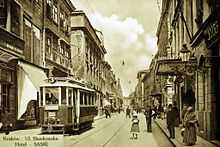





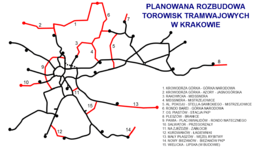

.jpg)

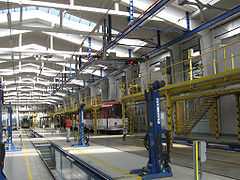



Origins
The first horse tram, 2.8 kilometres (1.7 mi) line was opened in 1882. It used narrow gauge tracks (900 mm) and ran from the railway station to Podgórski bridge. It was financed, constructed and operated by National Bank of Belgium. In 1901 the tram network was electrified and the formal opening of the first line took place on 16 March. The new SW1 class cars were produced by Sanocka Fabryka Wagonów. At the end of 1902, the system consisted of five electrified, narrow gauge lines. However, the network owners were primarily interested in the income generated by the existing lines, not in building new ones, which caused conflicts between them and the city council. The electrification and network extension was forced thanks to the Austro-Hungarian law changes favourable to the city. It stated that a railroad or a tram line could be operated only by a local company, registered in Austria. The private owners from Belgium were forced to create such a company, named Krakowska Spółka Tramwajowa, and transferred the agreement with the city to it. This took place in 1898.
Eventually, Kraków managed to buy 95% of shares of Krakowska Spółka Tramwajowa in 1910. In the same year, the city greatly increased in size by including several neighbouring villages and former military areas. New districts were created and it became clear that the narrow gauge network was not able to cope with the increasing transport needs. It was decided that a new network with standard gauge tracks will be constructed from scratch. In January 1913 the first standard gauge line (number 6) was opened, which ran from Zwierzyniecka Street, through Starowiślna to Trzeci Most. It operated SN1 class cars, also produced in Sanok. Before the world war, the new network replaced some of the narrow gauge tracks in the city centre.
Interwar and World War II period
In 1918, Poland gained independence from Germany, Austria and Russia. Kraków became one of the major cities of the newly formed country. One of the remnants from the Austrian regime was left-hand traffic. In the tram network, it was eventually abandoned in 1925. In addition to that, the supply limitations in the war period and the lack of qualified engineers caused great damage to the rolling stock quality. Unstable country economy made almost impossible to improve the situation in the first years of Polish independence. Eventually, the city government managed to establish a new tram company, Krakowska Miejska Kolej Elektryczna between 1924 and 1929.
The successful transformation allowed to repair the entire rolling stock and extend the network to the new districts, including Os. Oficerskie, Bronowice and Rakowice. The increasing number of cars created a need to build a new tram depot, since the old buildings in Kazimierz district turned out to be too small. In 1928, the city council offered a terrain for the new depot in Podgórze district. The construction began in 1937 and finished a year later. The further plans to extend the network were stopped by the war.
In the late 1920s it became clear that the construction of the new tracks to many districts would take several years. As a temporary solution, KMKE opened a bus communication. The buses were not supposed to compete with trams, and operated only on routes where the trams were expected to be introduced in the future.
Kraków survived the Nazi Invasion in 1939 relatively undamaged. Due to the confiscation of all the buses and private cars by the army, the tram became the only mean of transport in the occupied city. The new German government noticed the problem and imported 10 second-hand MAN Tw cars from Nuremberg and four others from the liquidated network in Eberswalde. Another movement was the introduction of lines for Germans only.
Post-war period
After the war, Kraków tram network suffered from the lack of tram cars. Furthermore, due to destruction of bridges on Vistula river, the network was split in two parts between 1945 and 1946. In 1950 and 1952 the tram tracks reached Borek Fałęcki and the new city district, Nowa Huta, founded four years later together with a steel mill to the east from the city centre. In 1953, a tram ring around the Old Town was finished. It allowed to close down the old, narrow gauge network in 1 January 1954 and remove tracks from the Marketsquare. In the next years, the new tracks were opened mostly in Nowa Huta and Podgórze. In 1969, a new tram depot in Nowa Huta was finished, after four years of construction. The old depot in Kazimierz was abandoned and adapted for other purposes.
After the nationalisation of Polish industry, the new communist government began construction of the national tram cars in Konstal factory, Chorzów. The first Konstal N cars appeared in Kraków in the late 40-ties. SN1 and even old Tw cars from Nuremberg (known as SN3 in Kraków) remained in service to the late 60s.
In the 1970s, the local authorities began an ambitious project of reorganizing the entire public transport in the city. Some of the goals were:
- Building a Metro (rapid transit) line from Bronowice to Nowa Huta.
- Rebuilding the main railway station to Kraków Communication Centre with integrated railway, bus, metro and tram services.
- Closing some tram tracks in the city centre.
- Building new tram tracks to the outer districts and a new tram depot.
Due to the lack of funding, very little was actually achieved. Between 1974 and 1990, only a single metro station was finished under the railway station.[2] In 1984, the first network extension to the north took place - the tracks reached the new XXX-Lecia district (currently Krowodrza Górka). Despite the crisis, the authorities decided to close down the tracks to Dworzec Główny Wschód (Railway Station East) as a preparation for the next part of the metro construction. The new balloon loop in Krowodrza Górka was also prepared for the further network extensions, but the actual works never started.
Present times
The government and economy changes caused the old plans to be abandoned. In 1994, the new authorities decided not to continue the metro line construction in favour of a fast tram. The first line was accepted to connect Krowodrza Górka in the north, with Kurdwanów in the south of the city, and use the existing tunnel under the railway station. The first stage of the tram tunnel construction took place between 1996 and 1999, from the railway station to Rondo Mogilskie.[2] At the same time, the tram network operator, MPK Kraków, began a process of replacing the old and unreliable Konstal cars. In 1989 it began to buy second-hand T4 cars with B4 trailers from Nuremberg, and later - GT6. In 1999, it managed to buy the first twelve low-floor Bombardier NGT6 cars.
In 1999 the first network extension since 1984 took place. The tracks reached Kurdwanów district, forming the first part of the Kraków Fast Tram network. The local authorities began a huge programme of tram infrastructure modernization. Between 2000 and 2010, nearly a quarter of the network went under a general reconstruction. In 2006 and 2007, Dworzec Towarowy was connected with an existing network through a new link on Pawia Street and the total network length reached 84 kilometres (52 mi). On 11 December 2008, the 1.4-kilometre (0.87 mi)-long tram tunnel was eventually opened after 34 years of construction.[2] Next day, the first fast tram line 50 began to operate.
Future
Tramway is the primary form of public transport in Kraków. Many further network extensions are planned for the future. In 2010, the construction of the new link to Płaszów district began, and another one to Ruczaj was opened in 2012. Other existing tracks are going to be updated to the fast tram standards.
Infrastructure
Today, the tram network consists of 90 kilometres (56 mi) of double track. Since the network is designed to be operated by single-ended trams, it has balloon loops at nearly all termini. There are currently 24 balloon loops in Kraków.
| Name | Opened in[3] | Number of tracks | Other infrastructure | Lines |
|---|---|---|---|---|
| Borek Fałęcki | 1950 | 3 | Passing loop for incoming trams | 8, 10, 12, 22 |
| Bronowice | 1937 | 2 | - | 14, 24 |
| Bronowice Małe | 1975 | 2 | Siding | 4, 8, 13, 64 |
| Cichy Kącik | 1902* | 2 | Siding | 20 |
| Cmentarz Rakowicki | 1934 | 1 | - | 2 |
| Czerwone Maki | 2012 | 2 | Siding | 11, 18, 23, 52, 62 |
| Dajwór | 1953 | 2 | Passing loop, wye (to Św. Wawrzyńca depot) | Unused |
| Dąbie | 1968 | 2 | - | 12 |
| Dworzec Towarowy | 1907 | 2 | Pass-by loop | 19 |
| Kopiec Wandy | 1977 | 2 | Part of the multilevel track crossing | 16 |
| Krowodrza Górka | 1984 | 3 | Extra stub-end | 3, 5, 18, 50, 69 |
| Kurdwanów | 2000 | 2 | - | 6, 24, 50 |
| Łagiewniki | 1938 | 3 | Pass-by loop | 19 |
| Mały Płaszów | 2010 | 2 | - | 11, 20 |
| Mistrzejowice | 1974 | 2 | Siding | 9, 14, 16 |
| Nowy Bieżanów | 1978 | 2 | Siding | 3, 9, 13, 23, 69 |
| Osiedle Piastów | 1976 | 2 | Siding | 21, 52, 64 |
| Pleszów | 1962 | 2 | Siding | 10, 21 |
| Prokocim | 1965 | 2 | - | 24 |
| Rondo Hipokratesa | 1966 | 2 | - | 52 |
| Salwator | 1917 | 2 | Siding | 1, 2, 6 |
| Walcownia | 1955 | 2 | Siding | 22 |
| Wieczysta | 1964 | 2 | Siding | 5 |
| Wzgórza Krzesławickie | 1968 | 2 | Siding | 1, 4, 5 |
- - moved to the current location in 1954.
Other termini
On Dworcowa street, there is located a double track wye which is occasionally used as an emergency terminus (usually when tracks to Kurdwanów and Bieżanów Nowy are blocked or they are cut off from the rest of the network for a longer time). A junction to Św. Wawrzyńca depot on Dajwór street sometimes serves as a wye, too.
In the past, Kraków network had some termini with simple stub-ends operated by double-ended cars (i.e. a narrow gauge terminus near the main railway station). After the war, they have been abandoned in favour of balloon loops, as the deliveries of single-ended trams proceeded. However, MPK bought recently a small fleet of second-hand double-ended cars from Nuremberg and Düsseldorf which are used during reconstructions and partial openings of unfinished network extensions. The first temporary stub-end appeared in 2006 on Politechnika stop, when the new tracks on Pawia street had not been connected yet to Dworzec Towarowy loop.
Small stub-end also exists on Krowodrza Górka, Bronowice Male and Salwator (end stops) but they are used as a track for defected and replacement cars, while double-ended trams use the balloon loop.
Tram depots
There are three tram depots in Kraków:
- Zajezdnia Podgórze (opened in 1938)
- Zajezdnia Nowa Huta (opened in 1969)
- Zajezdnia Św. Wawrzyńca (opened in 1882, reopened in 2009)
The last tram depot was reconstructed in 2008 and serves as a tram museum.
Kraków Fast Tram
Kraków Fast Tram (pl. Krakowski Szybki Tramwaj) is a developing fast tram network in Kraków. It consists of several modernized exclusive tram tracks with absolute priority on crossings, and an underground, 1.4 kilometres (0.87 mi)-long tunnel under the railway station with two underground stops. Contrary to many light rail systems, fast tram is not created by certain lines - the tracks are a part of the existing network and are used by ordinary lines, which benefit from moving through a fast tram link.[2] The stops at the fast tram tracks are equipped with an electronic passenger information system showing the real times of the tram arrival.[2] Since 2010, the system is going to be installed on classic tram links, too.
In addition to the ordinary lines, there are two 'fast tram lines' that move exclusively on the fast tram tracks:
- 50 - Krowodrza Górka - Kurdwanów
- 52 - Czerwone Maki - Osiedle Piastów.
The first fast tram line was opened on 11 January 2008, however it is not fully finished yet. Due to the missing tracks through Płaszów, it temporarily uses the link through Kazimierz and Podgórze districts, and short pieces of track are not separated from other traffic. Except that, the link is connected to the traffic light control system and passenger information system.
Lines
List of tram routes in Kraków as of December 2014. Currently, there are 27 tram lines.[4]
The frequencies are daytime Monday to Friday frequencies.
| |
|
|
|
|
|
|
 |
Wzgórza Krzesławickie | Salwator | |
|
|
|
 |
Salwator | Cmentarz Rakowicki | |
|
|
|
 |
Bieżanów Nowy | Krowodrza Górka | |
|
|
|
 |
Wzgórza Krzesławickie | Bronowice Małe | |
|
|
|
 |
Wzgórza Krzesławickie | Krowodrza Górka | |
|
|
|
 |
Kurdwanów | Salwator | |
|
|
|
 |
Mały Płaszów | Dworzec Towarowy | |
|
|
|
 |
Borek Fałęcki | Cichy Kącik | |
|
|
|
 |
Mistrzejowice | Bieżanów Nowy | |
|
|
|
 |
Pleszów | Borek Fałęcki | |
|
|
|
 |
Mały Płaszów | Czerwone Maki | |
|
|
|
 |
Borek Fałęcki | Dąbie | |
|
|
|
 |
Bieżanów Nowy | Bronowice Małe | |
|
|
|
 |
Mistrzejowice | Bronowice | |
|
|
|
 |
Mistrzejowice | Kopiec Wandy | |
|
|
|
 |
Czerwone Maki | Krowodrza Górka | |
|
|
|
 |
Borek Fałęcki | Dworzec Towarowy | |
|
|
|
 |
Bronowice | Mały Płaszów | |
|
|
|
 |
Pleszów | Osiedle Piastów | |
|
|
|
 |
Borek Fałęcki | Walcownia | |
|
|
|
 |
Czerwone Maki | Bieżanów Nowy | |
|
|
|
 |
Kurdwanów | Bronowice Małe | |
|
|
|
 |
Krowodrza Górka | Kurdwanów | |
|
|
|
 |
Czerwone Maki | Osiedle Piastów | |
|
|
|
 |
Czerwone Maki | Kombinat | |
|
|
|
 |
Bronowice Małe | Osiedle Piastów | |
|
|
|
 |
Krowodrza Górka | Nowy Bieżanów | |
|
|
|
Rolling stock
In service
Since 1994, MPK Kraków replaces the Polish rolling stock produced in Konstal with new, modern low floor cars and second-hand trams imported from Germany and Austria.
| Photo | Name | Year of introduction | Description | | Cars in service[r 1] |
|---|---|---|---|---|---|
 |
Konstal 105Na | 1979 | Produced between 1979 and 1992. It is 13.5-metre (44 ft)-long and can form longer trains (theoretically up to 5 cars, in practice the 2- and 3-car trains are operated).[5] Due to the unreliability and the poor technical design, it is slowly replaced by second-hand trams from Germany. | 126 | |
 |
Bombardier NGT6 | 2000 | Bombardier NGT6 cars are low-floor trams bought since 2000. There have been three deliveries so far: 12 cars in 2000, 14 cars in 2003 and 24 cars between 2007 and 2008. The trams have an electronic passenger information system. | |
50 |
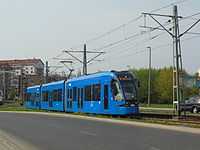 |
Bombardier NGT8 | 2012 | MPK Kraków is the only user of Bombardier NGT8 in Poland. | |
24[6] |
| |
E1 | 2004 | Produced between 1966 and 1976. Imported from Vienna since 2004. Some cars have got a partial electronic passenger information system. | 142[r 2] | |
 |
MAN N8S-NF | 2006 | These cars were produced between 1976 and 1977.[7] In early 90s, they were added a low-floor section.[7] Since 2006, they are imported from Nuremberg.[7] One of cars is a former narrow gauge M8S from Essen, bought initially for replacement parts, but later adapted to a standard gauge.[7][8] During the modernization, they have got an electronic passenger information system. | |
12 |
 |
Düwag GT8S | 2009 | Produced between 1973 and 1975 for Düsseldorf, Germany. In September 2009 MPK Kraków bought one of the cars for testing, and decided to import next 27 cars of this class.[9] During the modernization, they were equipped with an electronic passenger information system. In the near future, they are planned to get a low-floor module. It is worth noting that the cars retained their own rolling stock numbers from Düsseldorf.[9][10] | 28 | |
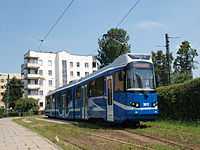 |
EU8N | 2010 | In 2008, MPK Kraków imported 25 E6+C6 trams from Vienna. Except one of them for a short period of time, they never appeared in a normal service, because they had to go through a general reconstruction. Using spare parts from the unnecessary C6 trailers, Autosan company produced a new low-floor module which was installed between the two sections of E6. The final assembly took place in MPK Kraków, where the trams got a new look. The new trams were given EU8N symbol. The internal equipment includes electronic passenger information system and air conditioning. The first EU8N appeared in service on 2 July 2010. | |
27 |
| |
Protram 405N-Kr | 2012 | 405N-Kr is an effect of reconstruction of three Konstal 105Na cars which have been connected with two new low-floor sections into a single car. The reconstruction was performed by Protram company located in Wrocław. The tram is 40.5-metre (133 ft) long. It has five sections. The total percentage of the low-floor area is 25%. The tram is equipped with a complete electronic passenger information system, air conditioning, and two ticket machines. It can take up to 364 passengers, including 64 on seats. The line service was started on April 20, 2012. There are plans to build next trams of this type. | |
1 |
| |
126N | 2013 | Prototype being tested since 26 June 2013. | |
1 |
Former types
In addition to the cars in line service, Kraków has a tram museum which is a part of the Muzeum Inżynierii Miejskiej (Museum of Urban Engineering) and it is located in the Św. Wawrzyńca Depot in Kazimierz district.
- Historical rolling stock in Kraków
-

SN1+P3 from 1912
-

LH Standard from Wrocław (1924)
-

SN2+PN2 from 1939
-

Another PN2 trailer from 1939
-

Konstal N+ND from 1954 operated by Silesian Interurbans
-

Konstal N from 1954 operated in Warsaw
-

Konstal 102N from 1964
-

Konstal 102Na from 1970, the oldest car of this type in Poland
References
Inline citations
- ↑ Budowa podziemnego tunelu dla linii Krakowskiego Szybkiego Tramwaju, "Construction of Kraków Fast Tram tunnel" (Polish)
- ↑ 2.0 2.1 2.2 2.3 2.4 Z przodu szybki, z tyłu szybki, stąd jest szybki - zikit.krakow.pl "Kraków Fast Tram information", the original title is a word game (Polish)
- ↑ Dates according to www.kmk.krakow.pl/petletram.html (Polish)
- ↑ http://rozklady.mpk.krakow.pl/
- ↑ Wagony 105N/105Na - mpk.krakow.pl "105N/105Na tram cars" (Polish)
- ↑ http://www.railjournal.com/index.php/light-rail/krakow-receives-final-flexity-lrv.html?channel=542
- ↑ 7.0 7.1 7.2 7.3 Wagon N8 - mpk.krakow.pl "N8 tram cars" (Polish)
- ↑ N8S-NF - psmkms.krakow.pl (Polish)
- ↑ 9.0 9.1 Wagony GT8S - mpk.krakow.pl "GT8S cars" (Polish)
- ↑ Wagenparkliste Düsseldorf "List of tram cars in Düsseldorf" (German)
Bibliography
- Jacek Kołodziej (2010). Krakowskie tramwaje (in Polish). Rybnik: Eurosprinter. ISBN 978-83-926946-9-4.
- Janusz Osman, Jan Koźmic (2008). Kronika krakowskich linii tramwajowych 1882 – 2007 (in Polish). Kraków: Muzeum Inżynierii Miejskiej w Krakowie. ISBN 978-83-926408-1-3.
External links
- MPK Kraków, tram network operator website (Polish)
- ZIKiT Kraków, the infrastructure owner website (Polish)
| ||||||||||||

